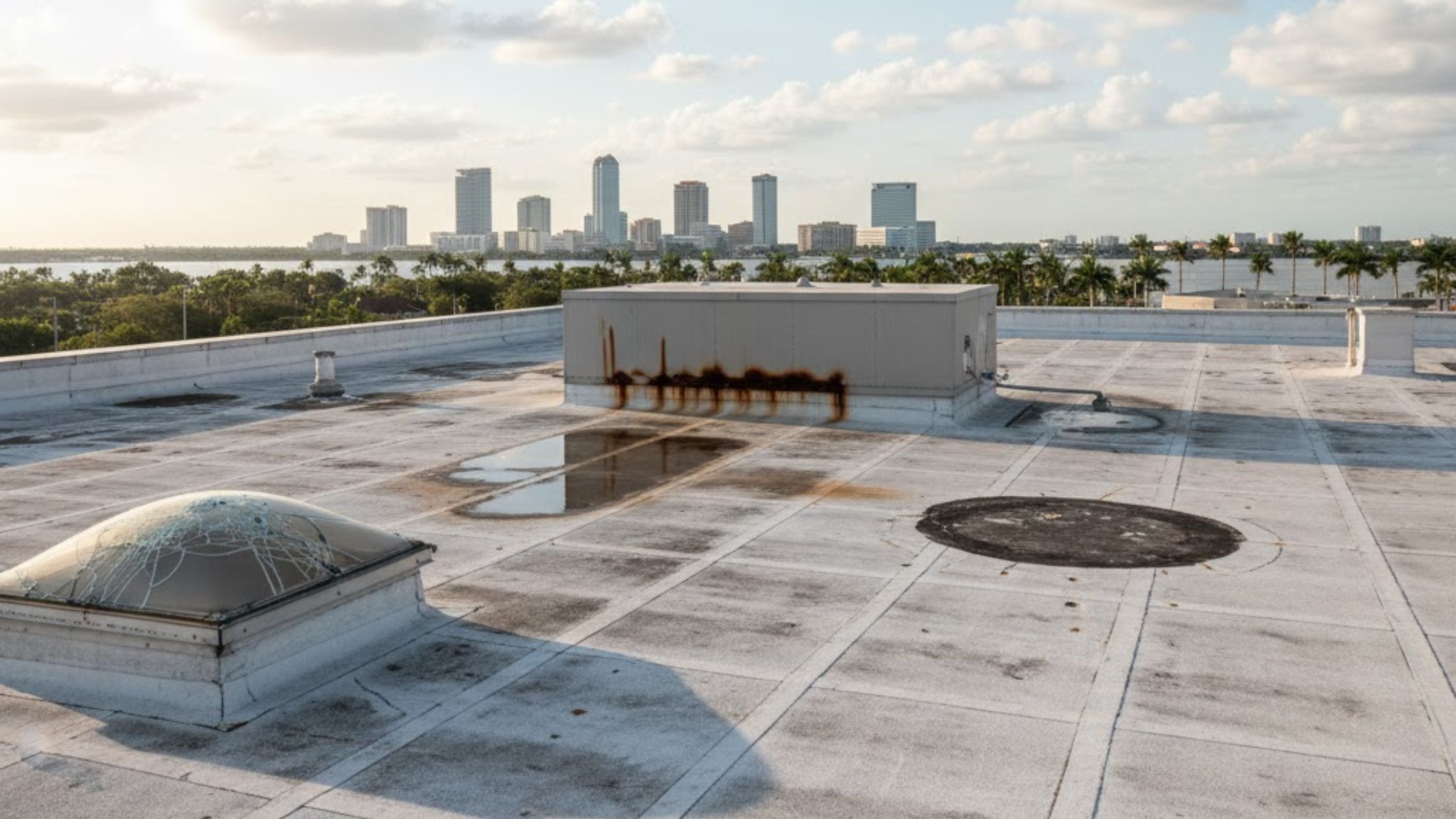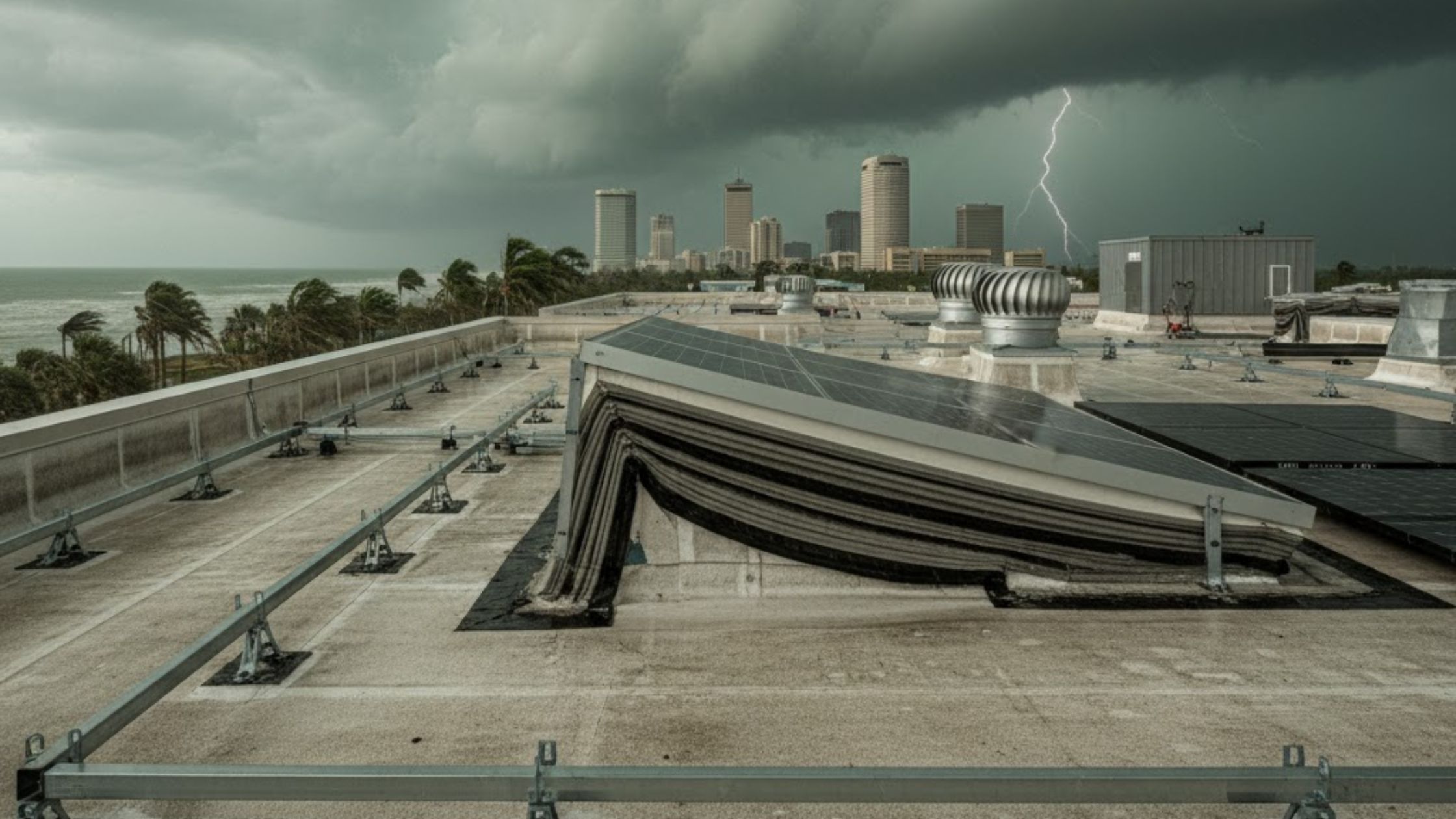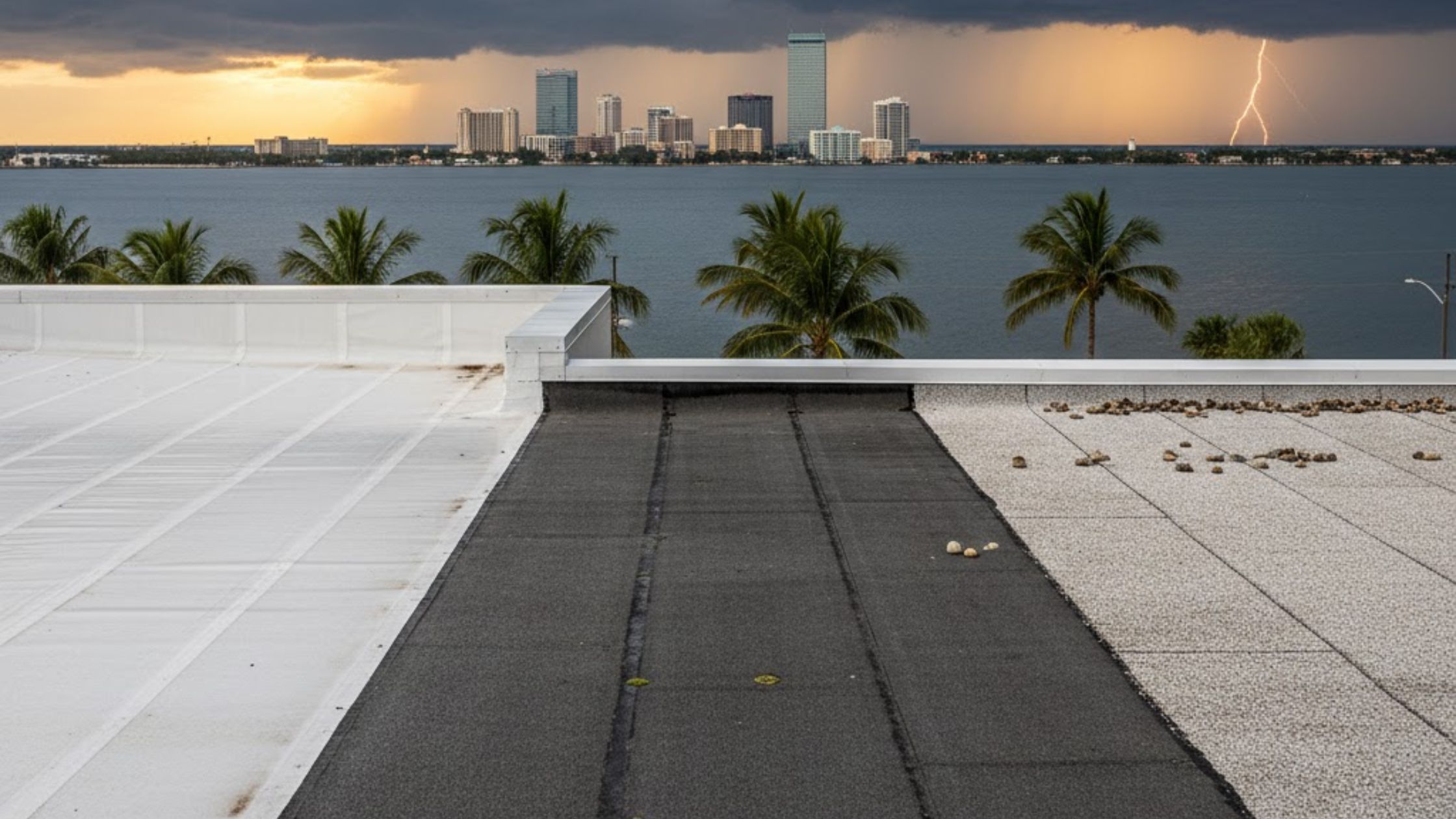What Safety Standards Should Tampa Businesses Expect During Commercial Roof Construction?
Tampa businesses should expect strict safety standards in commercial roof construction—covering OSHA compliance, fall protection & site safety. Learn more now!
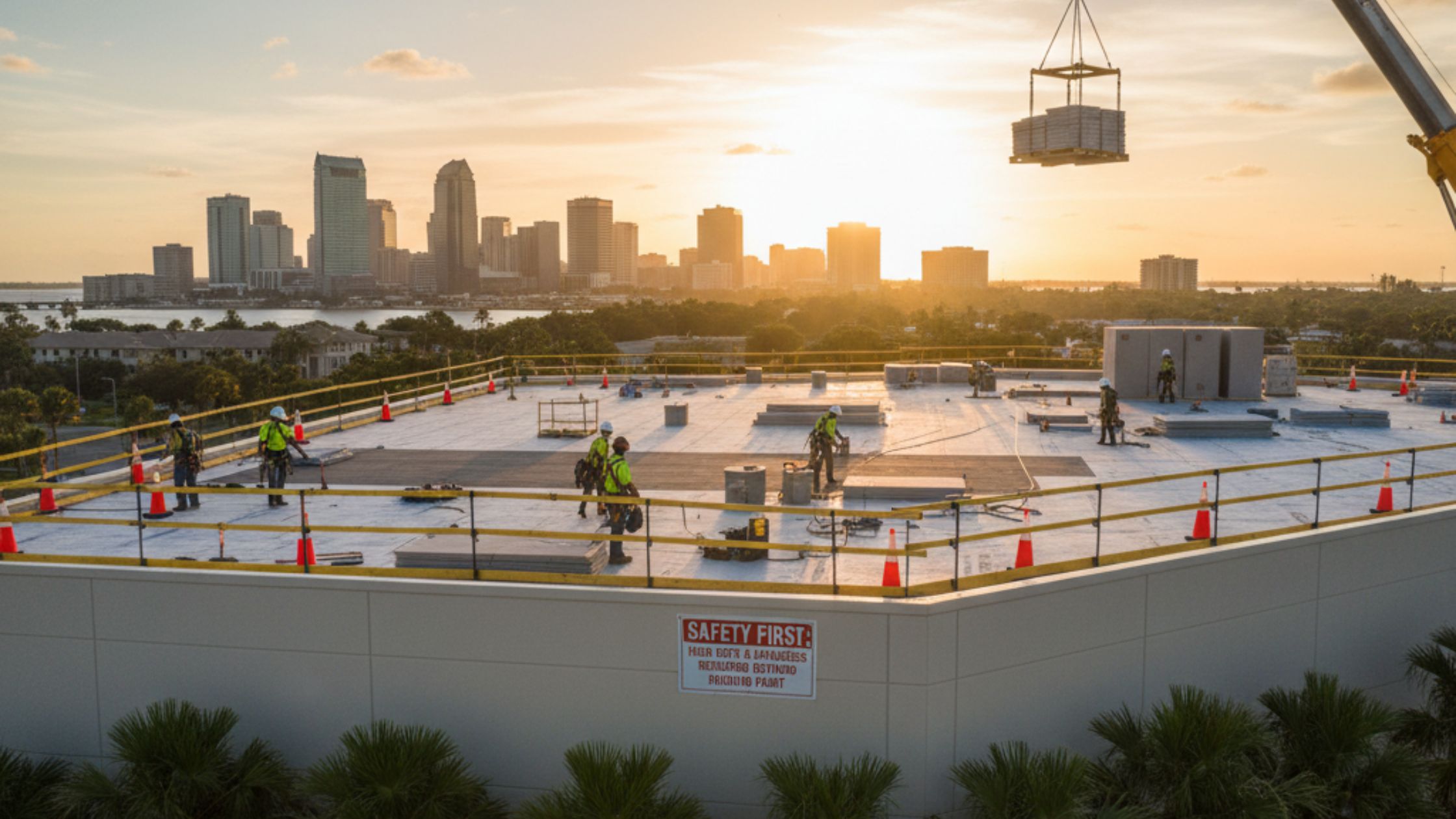
Embarking on a new commercial roof construction project is a significant investment for any Tampa business, representing an upgrade to asset protection and operational longevity. However, this process introduces serious safety considerations that go far beyond just the final installation of shingles or membranes. As a responsible business owner, understanding the rigorous safety protocols your contractor must adhere to is non-negotiable, not only to ensure compliance with federal and local laws but also to protect workers, building occupants, and your business's liability. A reputable partner for Commercial Roofing Tampa will make safety a primary and transparent focus of the entire operation, adhering to strict Occupational Safety and Health Administration (OSHA) standards and developing site-specific plans for the unique challenges of the Florida climate.
The commercial roofing industry is consistently ranked among the most hazardous construction sectors, primarily due to the ubiquitous risk of falls from height. Therefore, the foundation of every major project, whether a new installation or a large-scale repair, must be a comprehensive safety plan that addresses these core risks proactively. This plan involves more than just issuing hard hats; it dictates site access, equipment usage, material handling, and emergency response procedures to create a fully protected working environment. When you hire a professional service, you should expect this dedication to safety to be clearly documented and evident from the very first site assessment.
What are the top safety concerns for commercial roofing projects?

The primary dangers on a commercial roof site are manifold, extending well beyond the simple risk of a fall, although falls remain the leading cause of injuries and fatalities. Tampa’s unique environment, with its high humidity, intense sun, and frequent afternoon storms, introduces additional, regional-specific hazards that must be meticulously planned for. From electrocution risks posed by hidden power lines to the danger of fire from hot works, a professional contractor must systematically mitigate all foreseeable hazards.
The ever-present risk of falling from heights of six feet or more demands the implementation of strict fall protection commercial roofs systems. These are not merely optional accessories but mandatory requirements under OSHA's 1926.501(b)(1) standard. Falls can occur from unprotected roof edges, through fragile materials like aged skylights, or during the ascent and descent using ladders and scaffolds. Any competent contractor will present a detailed plan outlining how all of these potential drop zones will be secured before work commences.
Beyond the immediate height danger, the nature of the work itself creates other critical safety concerns, particularly with material handling. Workers are often required to lift heavy materials like insulation boards, asphalt kettles, or equipment, which can lead to musculoskeletal injuries if proper lifting techniques and mechanical aids are not utilized. The sheer size of many commercial properties also means a larger worksite, which increases the complexity of managing traffic, material storage, and general site housekeeping to prevent trips and slips.
The Cornerstone of Safety: Fall Protection Commercial Roofs
The single most important safety measure on any high-altitude commercial construction site is fall protection. For any walking or working surface with an unprotected edge six feet or more above a lower level, OSHA mandates a protection system must be in place. Business owners need to verify that their chosen roofing partner has a dedicated, multi-faceted strategy that employs a hierarchy of controls to meet this crucial safety standard.
Personal Fall Arrest Systems (PFAS) and Anchors
The core of a worker's defense is the Personal Fall Arrest System (PFAS), which is a comprehensive setup designed to safely stop a worker's fall. A PFAS consists of three main components: a full-body harness, a connector like a lanyard or lifeline, and a certified anchorage point. The proper use and inspection of this equipment are vital, as a system failure can be catastrophic.
OSHA dictates that the anchor point, which serves as the ultimate attachment point for a worker, must be capable of supporting at least 5,000 pounds of force per attached worker, a testament to the immense forces generated during a fall. Furthermore, the system must be rigged to ensure a worker cannot free-fall more than six feet or contact a lower level. This requires careful calculation of the fall distance, including lanyard length, deceleration device stretch, and a minimum safety margin.
Guardrail, Warning Line, and Safety Net Systems
While PFAS protects individual workers, perimeter controls protect the entire work zone and are often the preferred method of fall prevention. Guardrail systems act as a physical barrier and are required to be positioned 39 to 45 inches above the working surface, capable of withstanding a significant force. Where a guardrail is not practical, safety nets can be deployed beneath the work area, though they must be positioned no more than 30 feet below the working surface to be effective.
For low-sloped roofs, which are common in Commercial Roofing Tampa due to their cost-effectiveness and durability, a warning line system is often used. This system uses flags and ropes placed a minimum of six feet from the roof edge to alert workers to the hazard area. However, the warning line must be combined with another form of protection, such as a guardrail or a safety monitoring system, for any worker who needs to venture beyond its boundaries.
Ensuring Compliance: OSHA Roofing Safety and Training
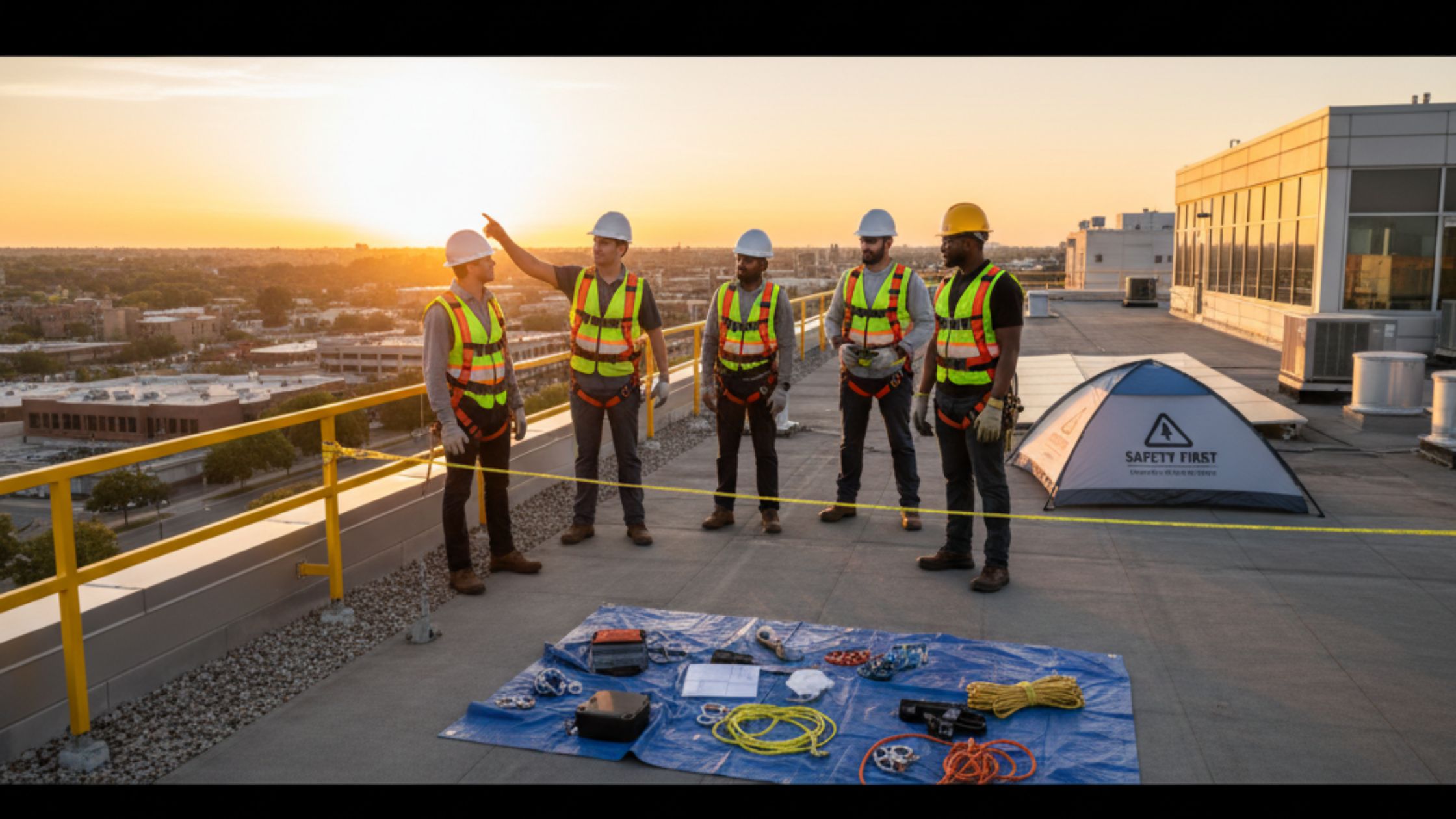
The legal framework for safety is defined by the Occupational Safety and Health Administration (OSHA), and compliance with these regulations is the contractor’s legal duty. For a business owner, ensuring your contractor’s adherence to OSHA roofing safety standards is your due diligence, protecting your company from the secondary liability and operational disruption that can result from a serious violation or incident on your property.
A licensed and reputable contractor will possess a clean safety record and a demonstrable commitment to continuous, mandatory safety training for all personnel. This training must cover a broad curriculum, including the correct donning and doffing of Personal Protective Equipment (PPE), hazard recognition specific to the site, and the procedures detailed in the emergency response plan.
Personal Protective Equipment (PPE) Mandates
PPE is the individual worker’s final line of defense against various construction hazards. While a PFAS protects against falls, a comprehensive PPE program covers all other exposure risks. Tampa businesses should expect to see roofers consistently utilizing:
- Head Protection: Hard hats or safety helmets to guard against falling debris and accidental impact.
- Eye and Face Protection: Safety glasses or goggles to shield against flying debris, dust, and chemical splashes.
- Foot Protection: Safety-toe work boots with non-slip soles for secure footing and protection from punctures or heavy falling objects.
- Hearing Protection: Earplugs or earmuffs to mitigate the risk of long-term damage from prolonged exposure to loud power tools.
- Hand Protection: Work gloves appropriate for the task, whether handling sharp metal flashing or working with abrasive materials.
Site-Specific Hazard Communication
Due to the use of various materials, including coatings, sealants, and solvents, a contractor must maintain a robust Hazard Communication program. This involves having Safety Data Sheets (SDS) readily available for all chemicals used on site and ensuring all workers are trained on the risks, handling procedures, and appropriate first-aid response for these materials. This commitment to chemical safety is an often-overlooked yet critical aspect of total contractor safety compliance.
Mitigating Climate and Environmental Challenges in Tampa
The unique climate of the Tampa Bay area presents safety challenges that go beyond typical construction hazards, requiring specialized protocols for heat and storm preparation. The extreme heat and humidity, particularly during the summer months, necessitate proactive measures to prevent heat-related illnesses among the work crew.
Protocols for Heat Stress and Dehydration
Roofers are exposed to high temperatures directly from the sun, coupled with the radiant heat from the roofing surface itself, which can lead to heat exhaustion and stroke. A comprehensive heat safety protocol should include mandatory water breaks, accessible shaded rest areas, and a structured work/rest cycle. OSHA suggests that new workers should acclimate slowly, beginning with only a fraction of their normal duration on the first day and gradually increasing over subsequent days.
In addition to heat, the notorious afternoon thunderstorms are a serious danger due to the risk of lightning and wet, slippery surfaces. The site-specific safety plan should clearly outline a procedure for monitoring weather forecasts and initiating a mandatory work stoppage before a storm arrives, ensuring workers can safely descend from the roof before conditions become perilous. This vigilance is paramount to maintaining a safe work environment in the unpredictable Florida weather.
When planning for these climate-related challenges, it is also important to consider the long-term protection of your building. Choosing a high-quality roofing system is key, and some businesses in the region are exploring Tampa commercial roofing for energy savings by selecting light-colored, reflective membranes that not only combat the urban heat island effect but also keep the building cooler, which is a major benefit to operations.
Site Management: Controlling Access and Material Flow
A professionally managed commercial roofing project should operate with precision, controlling all aspects of the site to minimize risk to workers and the public. Effective site management involves controlling the perimeter, securing materials, and managing the vertical access points to the roof.
Ladder and Scaffold Safety Requirements
Ladders and scaffolding are the primary means of roof access and are the source of many workplace accidents if improperly used. Contractors must ensure all ladders are OSHA-compliant, inspected before each use, and set up on stable, level surfaces at the correct 4:1 ratio (for every four feet of working height, the base should be one foot away from the wall). Furthermore, workers must maintain three points of contact (two hands and one foot, or two feet and one hand) when ascending or descending, never carrying tools that could compromise their grip.
Scaffolding, when required for complex facade work or high-rise structures, must be erected by trained personnel and inspected regularly. Key requirements include ensuring the scaffold is securely fastened, has a stable base, and incorporates guardrails on all open sides for platforms above ten feet. This foundational safety ensures that the equipment itself is a stable and reliable workspace, not a hazard waiting to happen.
Securing Roof Openings, Skylights, and Debris Management
Unprotected openings, such as skylights, access hatches, or holes created during construction, are a severe fall-through risk. Every roof opening must be protected by a secure cover that is capable of supporting at least twice the weight of workers, materials, and equipment. These covers must be clearly marked with the word "HOLE" or "COVER" to serve as a conspicuous warning.
A clean worksite is a safe worksite. Poor housekeeping, particularly the accumulation of debris, unused materials, or equipment, is a major tripping hazard on an otherwise flat surface. Effective debris management, including the use of chutes for material disposal and maintaining clear walkways, is a mandatory component of contractor safety compliance. Furthermore, securing materials against Tampa’s unpredictable high winds is essential to prevent items from being blown off the roof and striking pedestrians or property below.
The logistics of a commercial roofing project often require significant capital investment, and for many businesses, exploring ways to manage the outlay is a critical business decision. Learning about financing option for your project early in the planning phase can alleviate financial pressure, allowing you to focus on choosing a contractor who prioritizes safety above all else.
The Business Owner's Role in Commercial Roofing Safety
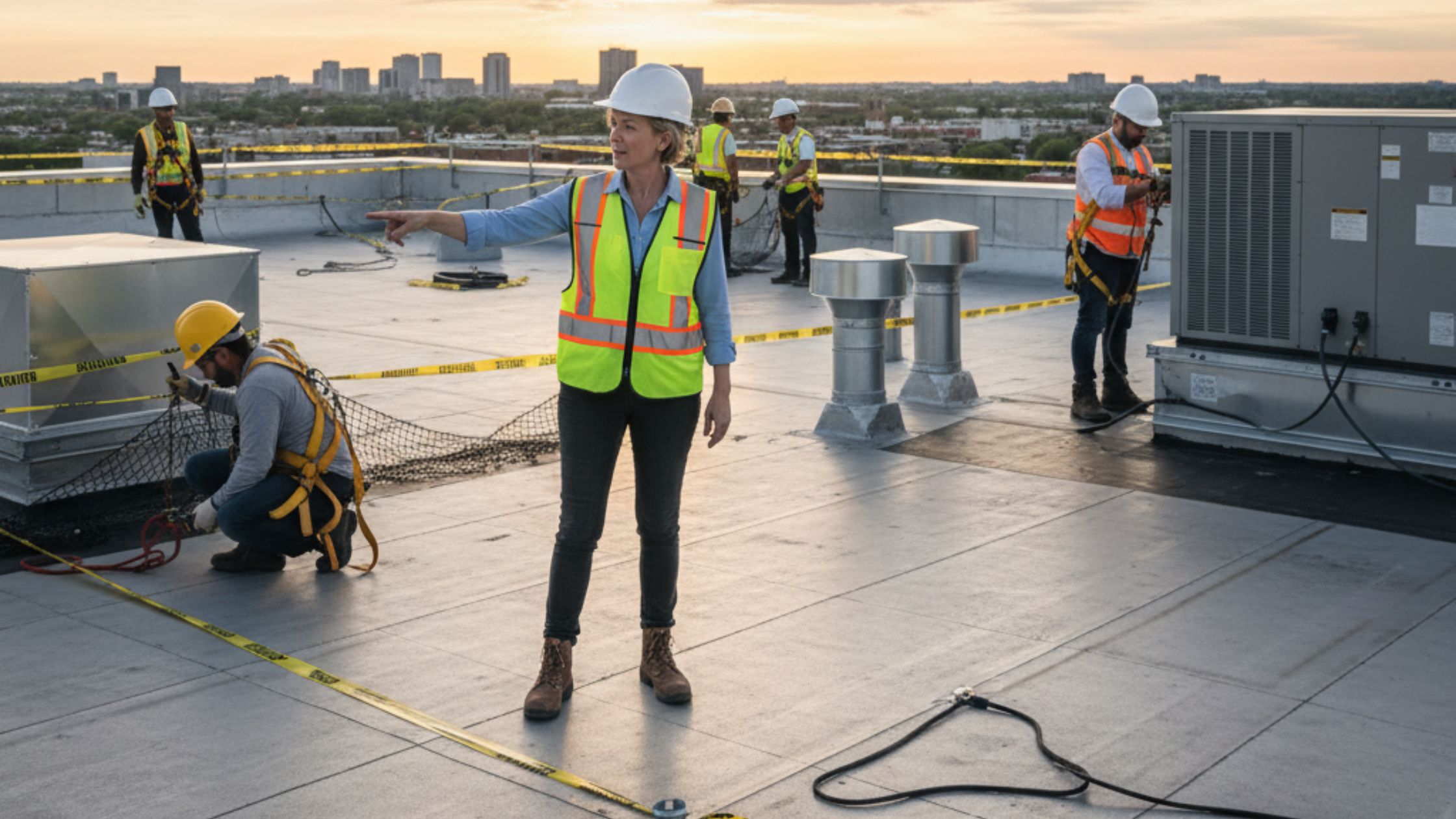
While the contractor is primarily responsible for implementing safety measures, the business owner has an active role to play in the due diligence process and in maintaining safety protocols throughout the construction timeline. Your involvement ensures that the standards are met and that the project minimizes disruption to your ongoing business operations.
Vetting for Proper Licensing, Insurance, and Safety Records
Before signing any contract, businesses must verify that the commercial roofing contractor holds all current Florida state licenses and carries adequate liability insurance and Workers’ Compensation coverage. This is your primary defense against liability should an accident occur. A reputable company will also have a verifiable safety record, often documented by an Experience Modification Rate (EMR) well below the industry average, demonstrating a historical commitment to safety excellence and low incident rates.
Part of the due diligence process should involve reviewing the contractor’s written safety plan before the project begins. This plan should be site-specific, addressing the particular risks of your building and its operation. If your facility, for example, is a school, a hospital, or a busy retail location, the plan must include enhanced provisions for pedestrian control barriers and clear communication with the public.
Coordinating with Ongoing Operations and Tenants
Many commercial roofing projects must be completed while the building remains fully operational. The contractor’s safety plan must therefore include strategies for minimal disruption and maximum protection for tenants and employees below. This often involves phased construction, secure exclusion zones marked by warning barriers on the ground, and noise mitigation planning.
The safety of the building’s interior environment must also be considered, particularly concerning fumes from hot applications like asphalt kettles or chemical coatings. The contractor must coordinate ventilation to prevent poor indoor air quality and potential health hazards for building occupants. This is especially important in Tampa’s humid environment, where proper moisture control is essential, a consideration that aligns with the benefits of good roof insulation benefits for Tampa’s hot climate.
Comprehensive Safety Training and Certification
The most sophisticated safety equipment is only as effective as the training of the individuals using it. The importance of ongoing, hands-on safety training cannot be overstated, as it builds a culture of safety among the workers and ensures proficiency in emergency response.
The Necessity of Specialized Training
A professional roofing team must receive specialized training beyond basic construction safety. This includes certification in the use of Personal Fall Arrest Systems, as well as specific instruction on the equipment they operate, such as hot tar kettles, motorized lifts, and nail guns. Training should not be a one-time event but a continuous process of refreshers and updates on new industry standards and technology.
This commitment to training extends to specialized certifications for hazardous materials, such as the safe removal and disposal of asbestos or lead, which may be present in older commercial roofs. A contractor’s willingness to invest heavily in the education and certification of their crew is the clearest indicator of their commitment to true contractor safety compliance.
When considering the long-term financial implications of a new roof installation, it’s worth investigating available incentives and assistance. You can find comprehensive details regarding Commercial roofing financing and tax incentives in Tampa which may help in budgeting for a superior, safer project.
Emergency Preparedness and Site Security
No safety plan is complete without a clearly defined, actionable emergency response plan (ERP). When an accident or emergency inevitably occurs, a quick, coordinated, and effective response can save a life and minimize disruption. The ERP is the safety team’s playbook for handling a range of worst-case scenarios.
The Emergency Response Plan Essentials
The site ERP must be communicated to all workers and on-site personnel before work begins. Key components of this plan include:
- First Aid and CPR: Ensuring that trained first aid and CPR responders are present on the job site at all times.
- Emergency Contact List: A readily accessible list of emergency services, including local hospitals, fire departments, and project management contacts.
- Rescue Procedures: Specific protocols for non-entry rescue of a fallen worker suspended in a PFAS, a situation where rapid response is critical to prevent suspension trauma.
- Fire Safety: A hot work permit system, readily available fire extinguishers, and a designated fire watch person when using equipment that generates heat or sparks.
- Hazardous Spill Response: Procedures for containing and mitigating spills of chemicals used on the roof.
The ERP should also address the security of the site after hours. Ladders must be secured or removed at the end of the day, and all materials and equipment must be safely stored in a secured area to prevent public access, theft, or vandalism. This is an integral part of maintaining safety and site integrity 24 hours a day.
For a deeper dive into how a detailed safety and maintenance plan can be customized for your specific property and operational needs, we encourage you to contact us to arrange a complimentary site assessment.
Securing Your Investment with Unwavering Safety
The choice of a commercial roofing contractor is a decision that impacts the immediate safety of your construction site, the longevity of your asset, and the long-term liability of your business. In a demanding market like Tampa, where the sun, storms, and humidity test every building material, the highest safety standards must be paired with superior craftsmanship. This dedication to excellence in both safety and quality should be the minimum expectation for any business investing in a new roof.
A truly professional partner will not view safety as a burdensome requirement but as a fundamental core value that protects every person and asset involved in the project. This deep commitment is reflected in every detail, from the use of certified fall protection commercial roofs systems to the rigorous adherence to all OSHA roofing safety protocols. You deserve a partner that delivers a top-tier project without compromising worker welfare or your business continuity.
Choosing the right partner means selecting a contractor with a proven track record of contractor safety compliance and excellence in service. When you are ready to move forward with your next Commercial Roofing Tampa project, trust only the experts who make safety their number one priority. This is the assurance that your business, your employees, and your new roofing system are protected from start to finish.
Frequently Asked Questions (FAQs) on Commercial Roofing Safety Standards
What is the minimum height requiring fall protection on a commercial roof?
OSHA mandates that employers provide fall protection systems for all workers on a walking or working surface with an unprotected side or edge that is six feet or more above a lower level. This critical standard applies across nearly all commercial roofing activities and construction sites to prevent one of the most common and severe types of workplace accidents.
What is a "Warning Line System" and how is it used on flat commercial roofs?
A Warning Line System is a safety protocol typically used on low-sloped commercial roofs to alert workers to the presence of an unprotected roof edge. It consists of ropes, wires, or chains and supporting stanchions, set up at least six feet from the edge. However, a warning line alone is often insufficient and must be used in conjunction with a guardrail, a safety net system, or a designated safety monitoring system.
How often must fall protection equipment, like harnesses and lanyards, be inspected?
Personal Fall Arrest Systems (PFAS) equipment, including harnesses, lanyards, and lifelines, must be inspected by the user before each use to check for wear, cuts, abrasions, or damage. Additionally, OSHA standards require a thorough inspection by a designated competent person on a regular basis, often annually or as specified by the manufacturer, with detailed records of these inspections maintained.
What precautions are necessary for working around skylights during a commercial roof project?
Skylights and other roof openings are serious fall-through hazards and must be protected. The required precaution is to cover every opening with a protective cover capable of supporting at least twice the weight of workers, materials, and equipment. These covers must be securely fastened and clearly marked with a hazard warning, such as "HOLE" or "COVER."
Is the contractor required to provide a written emergency response plan to the business owner?
Yes, a professional commercial roofing contractor is required to have a written, site-specific safety and emergency response plan (ERP). While the plan is primarily for their personnel, a reputable contractor will share the relevant details, including first-aid provisions, emergency contacts, and public protection protocols, with the business owner to ensure coordination and transparency during the project.
Final Words
When considering an investment of this magnitude, the contractor’s safety culture is as important as their technical skill. At CB Roofing Solutions, our decade-long experience in the Florida market is built on an unwavering adherence to the highest safety and construction standards. We view our proactive contractor safety compliance and comprehensive OSHA roofing safety training as a non-negotiable part of delivering superior quality and peace of mind for your Commercial Roofing Tampa project.

